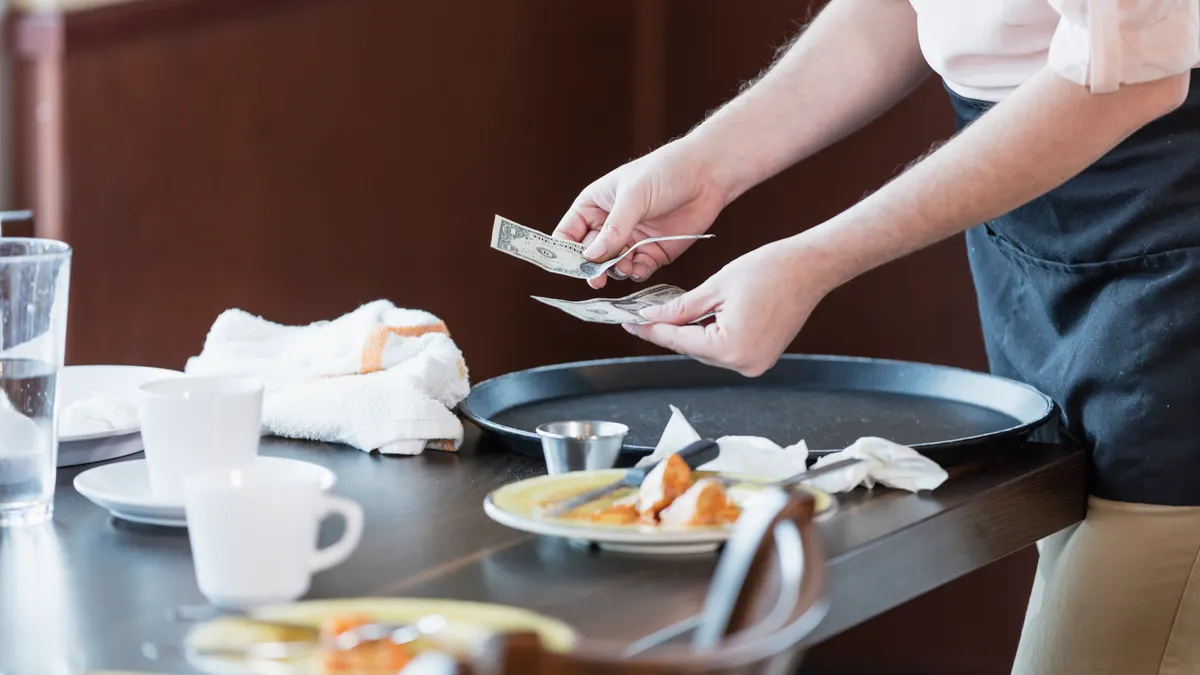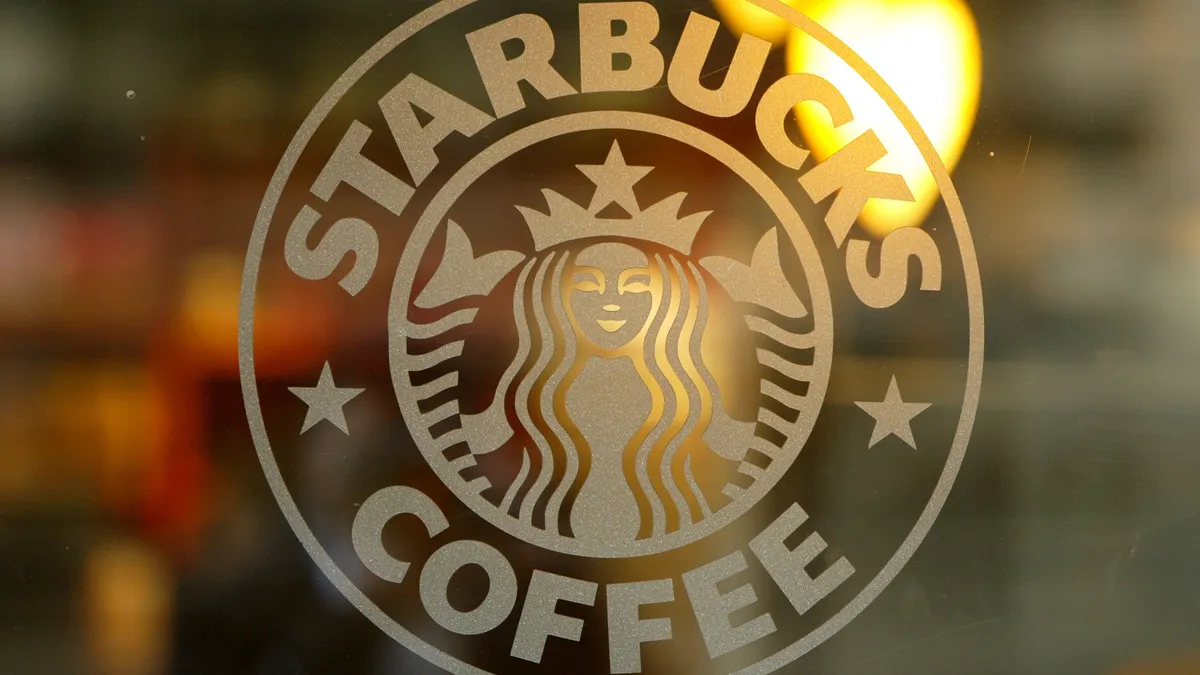For six years, Mikha Diaz ran a bar-meets-bookshop in the quirky San Francisco neighborhood of Hayes Valley. Two Sisters Bar & Books was a "small, hole-in-the-wall spot": eight employees, 850 square feet. The European-style bar served craft cocktails late into the night and had a miniature reading library the owners had curated.
But by 2016, Diaz had noticed dramatic increases in the bar's operating costs. The city's minimum wage had risen incrementally from $10.74/hour in Jan. 2014 to $13/hour by Jan. 2016 to keep up with rapidly rising rents. The increases drove up labor costs of experienced staff whose skills warranted salaries over minimum wage, pushing Two Sisters above the $150,000 threshold for the city's payroll tax.
"I couldn't get enough bodies in there even if I packed them in like sardines every night, which was what we were doing," Diaz told Restaurant Dive.
So, in October 2017 after shuttering Two Sisters, she opened Les Arceaux, a cafe and wine bar in Berkeley, with Alana O'Neal. But it, too, was closed after just five months: it was too expensive to fully staff the 2,100 square foot space, Diaz said.
Now, Diaz and Christin Evans run Alembic Bar, a late-night establishment in San Francisco's Upper Haight neighborhood, but high operating costs and diminished accessibility of labor remain their biggest obstacles in a precarious market.
In one of the most expensive regions in the country, which is also renowned for its culinary chops, high operating costs and a shortage of experienced talent is making operators wonder if the Bay Area's restaurant scene has an expiration date. A similar sentiment is felt among restaurateurs nationally, as workers are priced out of rising rent costs near city centers and independent operators are beset by high rent and labor costs. To survive, operators are testing innovative operational solutions that could keep them afloat without driving away talent. These tactics range from improving wait service to eliminating it altogether, and could hint at a new normal that's on the horizon for independently-owned restaurants across the country.
Investing in premium experiences or labor-saving tech
Nigel Jones, who owns Kingston 11 in Oakland, described his philosophy of sustaining the small-business ecosystem in the San Francisco suburb: "If you don't keep pace, you're not going to survive, and it's also important for me that my workers and people that I work with, including my suppliers, are able to make a good living," he told Restaurant Dive.
Jones pursues what he calls a "value-added approach", expecting that uniqueness of cuisine, high-quality service and presentation will soften the blow of slightly higher prices. "[If] jerk chicken, which was $18, now is $21, the plate looks the same, the flavors and everything stays the same, they're going to be wondering well, 'why am I paying more money for something which is essentially the same?' So you have to then provide a sense of premium in terms of experience," he added, outlining exemplary food presentation, attentive wait staff and efficient service as his primary strategies.
Eric Turner has a similar idea with Hip Hop Juice Box in Emeryville: "I wanted to create a space that I would love to hang out in and get work done," he told Restaurant Dive. The juice bar has a reliable revenue stream from consumers looking to host private events or office meetings, and its unconventionality has also made it an attractive space to music video producers and photographers, according to Turner.
In order to keep talented chefs while meeting customers' expectations that food is locally-produced and sustainably grown, operators are taking divergent approaches. Some, like Jones and Turner, are doubling down on training wait staff in quality service, betting that a personalized restaurant experience will outlast consumers' appetite for tech shortcuts.
On the other hand, new concepts such as Greek restaurant Souvla and bistro RT Rotisserie are having customers take on many of the roles expected of server or hosts with the assistance of point-of-sale technology. National chains are rolling out the tech on a grander scale, with Chipotle testing AI-powered voice assistance and several QSRs' pivoting to self-service kiosks.
A few restaurants, such as Zume Pizza, a delivery-only pizza company in the Bay Area, have gone a step further, powering food preparation with robotic technology that presses dough, spreads sauce and transfers pizzas into ovens. Caliburger and McDonald's are also testing robotic burger flippers and fryers, respectively, with a likely outcome of reducing labor costs.
Michael Lynn, a professor of consumer behavior at Cornell University and an expert on the tipped minimum wage, told Restaurant Dive that he expects restaurants' use of tablets or other capital-intensive technologies to only increase: "As labor costs go up, some businesses will go out of business, but others will start employing less labor, and they'll use technology to help them do that, so it'll be a different kind of service," he said.
"As labor costs go up, some businesses will go out of business, but others will start employing less labor and they'll use technology to help them do that, so it'll be a different kind of service."

Michael Lynn
Professor of consumer behavior and marketing at the Cornell University's School of Hotel Administration
Analysts point to "fine casual" as an emergent trend in the restaurant industry in expensive cities, as diners are looking for flexible and convenient options, but with high-quality ingredients and products. And for fast-casual or fine-casual restaurants, point-of-sale tech or design elements that minimize service costs are crucial to their profitability. By retaining an atmosphere of fine dining while cutting down on expensive wait service that also slow down table turnover, middle market restaurants may be able to sidestep the downward spiral of the casual dining segment brought on by oversaturation, the boom of fast casual and rising demand for convenience.
"A lot of places are getting their food that's already been prepped from a commissary ... and going automation so instead of having a host, you have a host stand where you're actually signing up yourself," Jeannie Kim, owner of SAM's Diner in the Mid-Market area of downtown San Francisco, told Restaurant Dive. Kim added that she expects to see the fast-casual segment continue to grow in major cities, as casual independent operators are either priced out, or forced to adapt to the new model.
Balancing menu prices with pay stubs
Mark Liberman, owner of Mago Restaurant in Oakland, doesn't employ bussers, expos or runners, and only has a host on the weekend. Instead, four chefs deliver the majority of diners' meals, which Liberman said creates a more interactive experience for the customers as well as cuts down on labor costs, allowing him to invest more resources in making the menu dynamic to seasonal produce that is organic and sustainably produced.
"A lot of people will be like, 'why don't you just pay [staff] more money?' and it doesn't work that way. We can but then we have to raise prices, and then people are like, 'why does this chicken cost $35?'" Liberman told Restaurant Dive.
Rising labor and rent costs aren't not the only operational challenges currently facing independent operators in the Bay Area and across the country. The prices of certain ingredients have also risen steeply, such as the price of fresh vegetables, up 28% in April year to date, and beef, up 4%.
And although the difference between the costs of buying organic compared to conventional products has shrunk from 9.5% to 7% since 2014, consumers' expectations that food be organic and sustainably produced has only increased, driven in particular by trends among the millennial and Gen Z demographics.
For Kim and Diaz, rising ingredient costs have made them evaluate supply chain purchases more regularly. "I'm gonna use dairy from a local ranch, but I might not use organic dairy from a local ranch. It's a perpetual conversation [of] how to get my guests the most bang for their buck," Diaz said.
"It's a perpetual conversation [of] how to get my guests the most bang for their buck."

Mikha Diaz
Co-owner, Alembic Bar
Some restaurants in cities with rising minimum wage rates have implemented a mandatory service charge to cover their costs or, less commonly, a "Community Value Contribution" surcharge that covers workers' health insurance. A surcharge enables operators to distribute wages more equally between back and front-of-house in a market where experienced chefs are increasingly scarce, but risks driving away customers, who, though may support higher wages in theory, are less willing to explicitly pay for them.
And in an effort to address the negative effects of a tipped wage such as higher rates of harassment and unstable wages, California implemented regulations mandating that stores pay the minimum wage rate on top of tips. However, the law means that some independent operators are less able to pay cooks in line with the wages front-of-house is receiving, while restaurants struggle to retain back-of-house talent. By passing on some table service duties to his back-of-house, Liberman can allocate a greater proportion of tips to back-of-house so they receive more competitive wages.
Improving culture and benefits to overcome the chef shortage
Bay Area restaurants face a particular challenge of tech giants' cafeterias luring talented chefs with attractive offers of sociable working hours, higher pay and benefits. But the dynamic reflects a broader challenge within the industry: deep-pocketed corporate brands, hotel and casino chains and catering companies are recruiting both culinary school graduates and experienced chefs in greater numbers, exacerbating a chef shortage.
For most independent operators, relying on workers' loyalty and fostering healthy working environments is the most feasible and cost-effective strategy to minimize turnover. In 2018, the food services and accommodation industry's turnover rate reached a post-recession high of 74.9%, according to the U.S. Bureau of Labor Statistics. The shortage of chefs could potentially force a reckoning for an industry infamous for its damaging, high-stress workplace environments, as operators look to improve workplace culture to halt employee turnover.
"Being away from the restaurant industry for two years opened my eyes a little bit to how burnt out I was, and I see so many chefs who are totally burnt out and don't want to cook anymore," Liberman remarked, on his evolution from being an authoritarian figure in the kitchen to a more positive, affirming presence. "Everyone talks about being sustainable, and for me, being sustainable is also I think [having] a sustainable life," he added. Prioritizing work-life balance — cooks at Mago Restaurant work four days a week, instead of five — doesn't come without a price, however. Since Mago opened in June, Liberman has consistently worked 16-hour days, six days a week.
"I think for many of us who've made a career in this industry, it's the dream to get to work 9-to-5 and to get health insurance, so if I'm a line cook with two young kids at home, I'm trying to do that," Diaz told Restaurant Dive.
Competing for chefs in a market flooded with non-traditional culinary jobs doesn't have one easy solution. Diaz has started covering transportation costs for Alembic Bar employees working past midnight who live further away, to retain staff working in a city increasingly unaffordable for all except from old Californian money or Silicon Valley tech elite. According to rental platform Apartment List, three counties surrounding the Bay Area have each seen a more than 100% increase in the number of residents whose commute is longer than 90 minutes between 2009 and 2017. "We literally started covering peoples' Lyft rides and Uber rides," Diaz said, "which you can imagine is no small cost".
"The folks who fill the minimum-wage positions — my dishwasher, my quarters — cannot afford to live in decent proximity to work," she added.
Some restaurant operators have also expanded their benefits packages to offerings such as health insurance and 401(k) matching to attract workers, but in regions like the Bay Area where living costs are prohibitively high, it's unclear whether this is the best path forward.
Azhar Hashem, who owned Tawla in San Francisco's Mission District, wrote in a blog post earlier this year that her employees asked for higher wages instead of private health insurance.
"When you're struggling to live paycheck to paycheck, it's hard to prioritize planning for the possibility of a health emergency," she wrote. Tawla, an upscale eastern Mediterranean restaurant, shut its doors after two years. Hashem attributed its closure to high costs of living and operating that created an impossible situation for the independent San Francisco restaurant. Even with a mandatory service charge that allowed her to pay back-of-house more and cover employees' commuting expenses, all but two of the 25-person team Hashem had started with had left, priced out of the city.
For Diaz, it's still too soon to know exactly what these changes will mean for the future of independently-run restaurants in San Francisco. But she has an inkling: "We might just see chunks of our industry disappearing around fine dining. The costs are so high and the margins are so small, there really is no room for error."




















